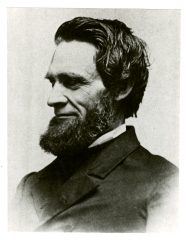capital. Brown and Judd had tapped a reservoir of emotion.
The transition of control in the University Board from the Rochester supporters to the Anti-Removalists was another dramatic episode of the 1850 commencement week. Thanks to the fact that Removal men had been appointed to vacancies, friends of Hamilton failed to constitute a quorum. In case the Removalists should refuse to meet, the University would be forced to suspend operations. That a quorum of any kind could be gathered after August, 1850, seemed improbable.
When the Trustees met on the 19th they were three short, and it was not until their third session, the afternoon of the 20th, that a quorum of nine was present. Knowing that a committee of Anti-Removalists was prepared to negotiate with the Board, five Removalists present agreed to resign and resolved:
that we pledge ourselves to elect substitutes on the nomination of Dea. Wm. Cobb, of Hamilton, provided a written pledge be first given by responsible individuals, that the professors who shall resign shall be paid in full on or before the 10th of September next, and that the bill of the Legal Committee at Albany … be paid by 1st of November next.*
The condition meant that friends of Hamilton, already staggering under a heavy deficit and hard-pressed to raise the endowment, would immediately have to secure $2,700 for faculty salaries and $265 for lawyers’ fees incurred by the Removalists. Though willing to pay the salaries, they regarded the legal expense as unjust and declined the condition. As the Board was about to dissolve without having surrendered control to the Hamiltonians, Professor Spear volunteered to assume responsibility for providing the money and Deacon Cobb, Alvah Pierce and three others joined in signing the bond. The Board accepted the document and six members withdrew one by one as Anti-Removalists took their seats. The crisis was passed and it was now possible to proceed with arrangements for carrying on the work of the University.
The newly constituted Board turned at once to the most urgent matter, that of reorganizing the faculty. Professors Maginnis, Conant, Raymond, A. C. Kendrick, and Richardson had resigned two days previously to accept appointments at Rochester, leaving only Eaton
*Colgate University, Board of Trustees, Minutes, Aug. 20, 1850.





